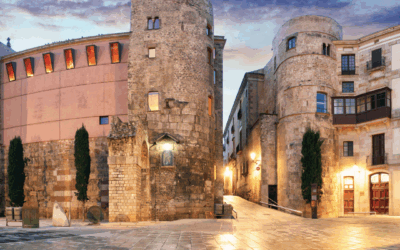The mountain of Montserrat is one of the most emblematic and mystical places in Catalonia. The Barcelona mountain is known for its distinctive rock formation, which has inspired legends and myths for centuries. Its name, which means “serrated mountain” in Catalan, refers to the sharp, jagged peaks that characterise its silhouette.
According to tradition, Montserrat has been a sacred place since time immemorial, and its history is deeply intertwined with spirituality and religion. It attracts pilgrims, tourists and nature lovers from all over the world. But beyond its famous monastery and hiking trails, the mountain harbours numerous secrets waiting to be discovered.
One of these secrets is the ancient Balneari de La Puda de Monterrat. In this text, we will explore its most fascinating aspects, including history, legends and evolution. Shuttle2Sun offers you low-cost and sustainable shared transfer services and private transfer services to Barcelona, from Barcelona airport, Barcelona port, Reus airport, Girona airport and Camp de Tarragona AVE train station. Remember that you can book your transfer up to 24 hours in advance.
A history of more than 300 years
Located in the north of the Baix Llobregat region, in Esparraguera, we find the Balneari de La Puda, a historical treasure hidden beside the Llobregat river, at the foot of Montserrat.
This place, which is now in ruins, was first mentioned in 1718 when Dr Salvador carried out the first chemical analysis of the thermal waters that gushed out of the Llobregat river. The waters, which emerge at a temperature of between 25 and 35ºC and are rich in sulphates, bicarbonates, chloride, sodium and calcium, have since shown curative properties, especially for dermatological, rheumatic and respiratory problems.
The origin of these thermal waters is linked to the Lisbon earthquake of 1755, although Dr Salvador’s analyses were documented a few years earlier, in 1718. Some time later, in 1818, the medicinal use of these waters was formalised and the first licence to build a spa was granted to Salvador Garriga, a tailor from Esparraguera, who in 1829 began the construction of two bathing buildings located on both sides of the river, taking advantage of the thermal currents.
Tragedy was not long in coming, as in 1831, due to financial problems, Garriga took his own life, leaving the project unfinished. His brother, Pau Garriga, together with two partners, finished the construction and in 1834 the spa began to operate.

However, the floods of the Llobregat river in 1842 and 1843 caused floods that damaged the facilities, bringing them almost to ruin. Finally, in 1844, Antoni Pujades bought the spa with the intention of renovating it and building an asylum, a project that did not succeed.
Years later, in 1870, the true splendour of La Puda arrived, when the buildings we know today were begun. At the end of the 19th century and the beginning of the 20th century, La Puda became a luxury destination frequented by the Catalan bourgeoisie. During the years between 1917 and 1924, the spa experienced its golden age, offering treatments for illnesses such as psoriasis, arthritis and respiratory ailments. Queen Isabel II of Spain is even said to have visited La Puda for treatment of certain pathologies.
Remember that Shuttle2Sun offers you its shared transfer services and private transfer services, low-cost and sustainable, from Barcelona airport, Barcelona port, Reus airport, Girona airport and Camp de Tarragona AVE train station.
Fall into oblivion
The Spanish Civil War and Franco’s dictatorship marked the beginning of the decline of La Puda. The facilities deteriorated due to lack of maintenance and the continuous flooding of the Llobregat river. In 1958, a heavy flood caused the definitive closure of the spa. Although in 1964 an attempt was made to revitalise the place by opening a restaurant and a room for events, a new flood in the 1970s left the ground floor full of damage, putting an end to this second life.

With the passage of time, the spa fell into oblivion. The buildings, victims of neglect and vandalism, began to fall down. Vegetation invaded the ruins, and what was once a place of luxury and wellbeing became a desolate and sad place.
Secrets and legends of La Puda
The mystery and decadence of the spa have only fuelled its legend. It is said that the waters of La Puda not only had healing properties, but also magical powers. According to some stories, those who immersed themselves in these waters experienced visions or received revelations about their future.
One of the most intriguing legends tells of a mysterious visitor who appeared on full moon nights. This enigmatic character, described as an older man in ancient clothing, offered advice and predictions to those who encountered him. It is thought that he could be the spirit of the old spa doctor, who still watched over the health of visitors.
In addition, it is remembered that during the Civil War, some local inhabitants hid valuables in the spa to protect them from looting.
Although many have tried to find these treasures, so far nothing has been discovered, which only adds to the mystery surrounding La Puda.
The spa, today
Today, although in ruins, it still attracts visitors seeking to explore its secrets and enjoy the surrounding natural environment. The decaying structures and invasive vegetation create a striking visual contrast, making it a popular destination for photographers and the curious.
There have been several attempts to restore it to its former glory. Conservation groups and local associations have proposed projects to rehabilitate the facilities and turn the site into a centre for sustainable tourism. However, these efforts have encountered many obstacles, from funding problems to legal complications related to land ownership.
Despite these challenges, interest in La Puda is still alive and well. If you too have been awed by its history, we encourage you to visit on your own. Remember that with Shuttle2Sun‘s low-cost and sustainable shared transfer services and private transfer services, you can travel to the area from Barcelona airport, Barcelona port, Reus airport, Girona airport and Camp de Tarragona AVE train station. Remember that you can book your transfer up to 24 hours in advance.



